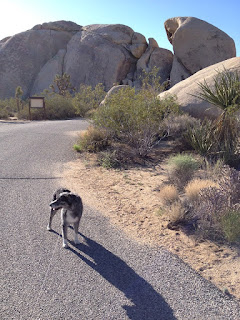 |
| 03/09/2020 A big Joshua tree in the middle of a Joshua tree forest. |
 |
| Sunday, March 08, 2020. Sun and rocks behind a dead Juniper tree. |
The weather Sunday and Monday was just about perfect: sunny, calm, with temperatures in the 60s during the day and 40s at night. The clouds were thickening all day Monday and by 4 pm it looked like a was storm moving in. I got back to Poway about 8 pm Monday night and by 9 pm it was raining. Great timing!
 |
| April 2015 Chynna (my Aussie dog) in Joshua Tree National Park. |
 |
| Indian Cove campground. Our campsite next to the rocks. White-throated swifts were flying arond the rocks behind us. |
This time, I decided to reserve a site several weeks ahead. The only campground with sites available during the week that had 3 days open was again, Indian Cove. But it is a beautiful campground with sites surrounded by the same rocks that Joshua Tree is known for.
 |
| Some animals we saw on the trails or in the campsite. Clockwise, Antelope squirrel, common raven, Sonoran gopher snake, Western Side-blotched lizard, Pinacate beetle, Desert Cottontail. |
The campground is actually within the park boundaries, but doesn't connect directly by road with the rest of the park. So we had a 15 minute drive each day to get back inside the park. It was worth it. The campground was very quiet and serene. Sunday night was the night of a super moon, so there was no Milky Way to be seen, but the brightness of the moon made up for it. I longed to be able to take the time to sketch, but being there such a short time I only did a quick sketch of the campsite and filled in a few of the animals we saw after I got home.
 |
| 3/09/20 Wall Street Mill Trailhead. |
Most of what we saw at JTNP consisted of rocks and trees, but very impressive looking rocks and trees! We did go on one hike to see some historical landmarks. It was only about 1.2 miles from where we parked to the gold mill, but that apparently was enough to discourage most of the tourists. All the parking lots were full and I had to time it right to get a space as someone drove away, but we hiked back to the mill pretty much by ourselves.
Wall Street Mill was active during the 1930s and 40s. It was used to crush and mill ore to extract the gold. There are several brief, but interesting, stories explained about the history of the site at plaques in the area.
 |
| View looking up hill from the end of the Wall Street Mill. Gold was extracted from rock ore at this site. |








